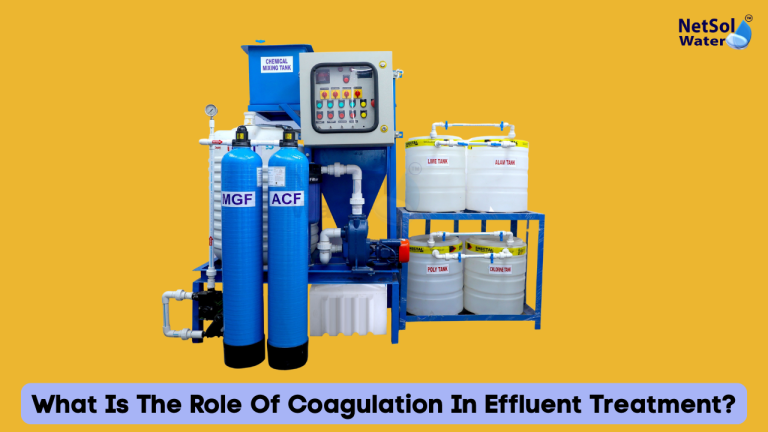
Effluent treatment is the process of purifying wastewater so that it can be safely released into the environment. Among the first processes is coagulation. But why and how do they coagulate? Knowing about the role of coagulation in effluent treatment makes it easy to imagine how clean water turns clean again. Here, in this blog, we are going to describe what coagulation is, how coagulation takes place, and why coagulation is needed to make wastewater free from dirt and safe. In this blog we will discuss about the What Is The Role Of Coagulation In Effluent Treatment.
What Is Coagulation?
Coagulation is a chemical treatment process for the removal of minute particles, dust, and other suspended impurities from wastewater. The particles are finer than those that can be filtered out or settle from water by themselves. To initiate coagulation, a certain chemical known as a coagulant should be added to water, which enables minute particles to stick together and eventually grow into big clumps. Such clumps, known as flocs, are heavier and hence settle more rapidly.
In a nutshell, coagulation is utilized to cause invisible dust to clump so that it becomes easy to remove from water through skimming.
How Does Coagulation Work?
When coagulants treat wastewater, they neutralize charges that exclude small particles from adhering to one another. Particles naturally repel each other and don’t adhere to one another. Repulsion is lessened by coagulants, and particles adhere and clump and bind together and form huge aggregates.
Some of the common coagulants used are aluminum sulfate (alum), ferric chloride, and other metal salts. These immediately react with the particles and assist in the floc aggregation. The water then proceeds to the subsequent process called flocculation where the flocs increase in size and tensile strength under soft agitation before filtering out or settling out.
Why Does Coagulation Matter in the Process of Wastewater Treatment?
Now, as we know how coagulation in effluent treatment works to improve water quality. Next, let’s talk about the main advantages of it:
1) They Eliminate Suspended Solids
Most suspended solids in wastewater are of a size too small and are not gravity settling-susceptible. Coagulation causes such suspended solids to aggregate as coalesced flocs that can be easily drained out of the sedimentation tanks by causing them to settle.
2) They Decrease Turbidity
Turbidity is the hazy or opaque nature of water due to suspended particles. When the particles are cleared by coagulation, the water becomes cleaner and fresher.
3) Eliminates Toxic Pollutants
The coagulation dislodges bacteria, viruses, and organic substances that stick to the particles. The water to be treated is safe and of better quality.
4) Enhances the Performance of Other Treatment Processes
After removing most suspended material, coagulation allows other steps to function more efficiently and lasts longer.
Where Does Coagulation Fit in the Treatment Process?
The process of coagulation in effluent treatment is normally followed by preliminary operations such as screening and grit removal and then filtration and disinfection. Water is slightly agitated in a flocculation basin after adding coagulant to create large flocs. Water is permitted to flow into sedimentation tanks in which flocs settle and are washed away as sludge.
The process effectively separates water from solid waste gently, and other treatment processes become easier and effective.
Problems and Points to Remember
Although coagulation is very effective, its process has a few disadvantages:
1) Selection of the Effective Coagulant: Various wastewaters need various coagulants for optimal effects.
2) Precise Dosage: Lesser coagulant will not create proper flocs, while in excess, it will result in chemical wastage and higher expenses.
3) pH of Water: pH of wastewater affects coagulation efficiency and hence might have to be altered.
4) Sludge Disposal: The coagulated sludge that has been settled must be disposed of in a way that it does not create any environmental problem.
Good monitoring and control will make sure that coagulation will take place as normal and for the whole treatment process.
Conclusion
The use of coagulation in effluent treatment is a significant part of the process of trying to clean grimy, dirty water into cleaner and healthful water. So when you talk about What Is The Role Of Coagulation In Effluent Treatment in above article we mentions all the factors that tell importance of coagulation in effluent treatment. Coagulation eliminates solids, turbidity, and enhances other treatment processes as it causes microscopic particles to cling to one another and settle out. Without the use of coagulation, it would be very difficult to be able to eliminate a great deal of impurity effectively. This straightforward but efficient process has an important contribution to environmental and public health protection. Visit our official website for more information and buy the best water treatment plant for your needs.
Do you need an advice or assistance on selecting the best water and waste water treatment unit? We have solutions for all your problems!
Let us know your problem, our experts will make sure that it goes away.
For an assistance or related query,
Call on +91-9650608473
Or write us at enquiry@netsolwater.com
